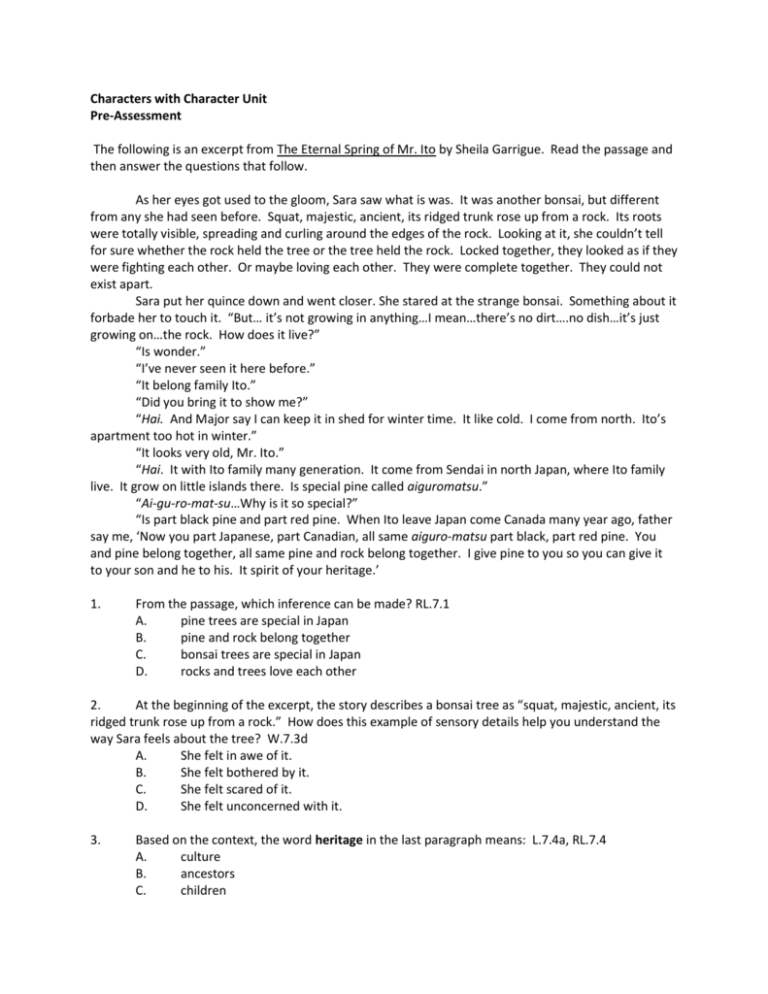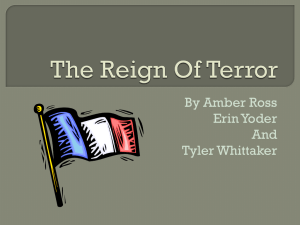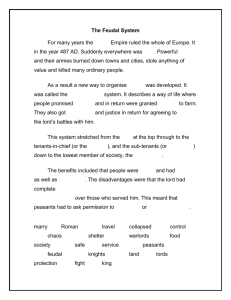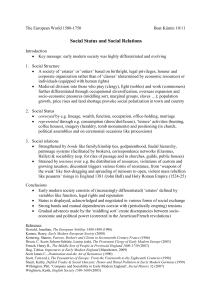Study Guide for Unit 1 Test
advertisement

Characters with Character Unit Pre-Assessment The following is an excerpt from The Eternal Spring of Mr. Ito by Sheila Garrigue. Read the passage and then answer the questions that follow. As her eyes got used to the gloom, Sara saw what is was. It was another bonsai, but different from any she had seen before. Squat, majestic, ancient, its ridged trunk rose up from a rock. Its roots were totally visible, spreading and curling around the edges of the rock. Looking at it, she couldn’t tell for sure whether the rock held the tree or the tree held the rock. Locked together, they looked as if they were fighting each other. Or maybe loving each other. They were complete together. They could not exist apart. Sara put her quince down and went closer. She stared at the strange bonsai. Something about it forbade her to touch it. “But… it’s not growing in anything…I mean…there’s no dirt….no dish…it’s just growing on…the rock. How does it live?” “Is wonder.” “I’ve never seen it here before.” “It belong family Ito.” “Did you bring it to show me?” “Hai. And Major say I can keep it in shed for winter time. It like cold. I come from north. Ito’s apartment too hot in winter.” “It looks very old, Mr. Ito.” “Hai. It with Ito family many generation. It come from Sendai in north Japan, where Ito family live. It grow on little islands there. Is special pine called aiguromatsu.” “Ai-gu-ro-mat-su…Why is it so special?” “Is part black pine and part red pine. When Ito leave Japan come Canada many year ago, father say me, ‘Now you part Japanese, part Canadian, all same aiguro-matsu part black, part red pine. You and pine belong together, all same pine and rock belong together. I give pine to you so you can give it to your son and he to his. It spirit of your heritage.’ 1. From the passage, which inference can be made? RL.7.1 A. pine trees are special in Japan B. pine and rock belong together C. bonsai trees are special in Japan D. rocks and trees love each other 2. At the beginning of the excerpt, the story describes a bonsai tree as “squat, majestic, ancient, its ridged trunk rose up from a rock.” How does this example of sensory details help you understand the way Sara feels about the tree? W.7.3d A. She felt in awe of it. B. She felt bothered by it. C. She felt scared of it. D. She felt unconcerned with it. 3. Based on the context, the word heritage in the last paragraph means: L.7.4a, RL.7.4 A. culture B. ancestors C. children D. principles 4. The BEST theme for this passage is: RL.7.2 A. People can be a part of multiple cultures B. People all have the same needs and wants C. People can all learn to get along D. People care about things in nature 5. The dialogue in this passage is MAINLY used to: W.7.3b A. describes the setting B. establishes the conflict C. establishes the characters D. furthers the plot Medieval People (from http://www.historyforkids.org/learn/medieval/people/index.htm) The way people thought about each other in the Middle Ages, everyone was involved in complicated systems of relationships with each other. Some people were still slaves, as in the Roman period, but not so many as before. Slavery was gradually dying out during this period. The first relationships people had were with their own families. In medieval European families, most kids lived with their father and mother and brothers and sisters. Because people died young from diseases, a lot of kids also lived with other relatives, or just with an older brother or sister, because their parents had died. Most kids never knew their grandparents, who had died before they were born. In the Middle Ages, hardly anyone went to school. Kids worked in the fields, or took care of younger brothers and sisters. A few children, usually from richer families, were given to monasteries or abbeys to be monks and nuns, and these children were sometimes taught to read and write. The children of very rich men and women sometimes had tutors at home. Teenagers, on the other hand, often went out to work for somebody else. Sometimes they worked for their neighbors, helping to plow the fields or take care of babies or animals. Sometimes they worked for richer families as servants, like Chaucer did. Or they were apprenticed to learn a skill like weaving or blacksmithing. Many teenagers lived with the people they worked for. Most peasants rented land from a richer man or woman who owned a big estate. They owed their landlord or landlady rent, and also a lot of other obligations. The peasants had to go to war with their landlord if there was a war, and they had to work a certain number of days every year for their landlady. Often peasants had to give their landlord or landlady a certain number of chickens or a certain amount of honey or spun wool or firewood every year. Even peasants who owned their own land often had some of these obligations to the nearest powerful person. In exchange, the powerful person was supposed to protect the peasants from invasions and from the king, and give them food when there was a drought, and enforce the law (which was mainly whatever he or she said it was). Each of these powerful people, in turn, owed obligations to a more powerful person - each count or countess, for instance, owed obligations to a duke (or duchess) or an earl. If there was a war, the count had to go to the war with his peasants, to fight for the duke. And the count had to send valuable presents to the duke as well, every year. In exchange, again, the duke was supposed to protect the count. Over everybody was the king or queen. Even the dukes and earls were supposed to fight for the king or queen and send him or her presents. But a lot depended on the king being strong enough to make them! Sometimes if the duke was strong enough, he just refused to come. Some peasants also rented land from the Catholic Church, which owned about a third of the land in Europe during the Middle Ages. Their landlord would be a bishop instead of a count, and over the bishop was the archbishop, and then the cardinal, and over all of those the Pope in Rome. And some people became monks or nuns, in the service of the Church, instead of being peasants. 6. Which piece of evidence BEST supports the inference Medieval people did not have advanced medicine? RI.7.1 A. hardly anyone when to school B. people died young from diseases C. land was often invaded D. they were apprenticed to learn a skill 7. The fourth paragraph uses the transition “on the other hand”. What is the purpose of this transition? A. to show the sequence of events (order). B. to describe the location. C. to develop theme. D. to move from one topic to another 8. Identify the capitalization error in the following sentence: “Sometimes they worked for richer families as servants, like chaucer did.” W.7.5 A. “chaucer” should begin with a capitalized letter B. “Sometimes” should not begin with a capitalized letter C. “servants” should begin with a capitalized letter D. “families” should begin with a capitalized letter 9. Brad loves nature and the environment. What might he study in college? L.7.4c A. ecology B. geology C. zoology D. biology 10. This is a document that people, such as teachers, earn to show that they know what they are doing. L.7.4b A. credential B. creditor C. credit D. creed






